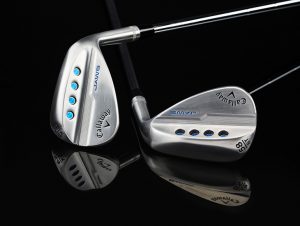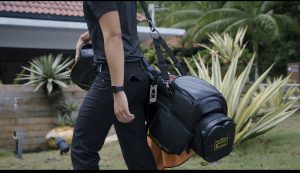Distance For the Rest of Us
POWER PRINCIPLE #1
Launch it high
A high launch delivers a yard-munching trajectory. At impact, Joe Miller’s driver is swinging upwards at a 10-12º degree angle, launching the ball at around 17º. Miller’s figures are pretty extreme, but if you can raise your launch you can add easy yards. Follow these four steps.
1. Promote launch through posture.
Take your regular driver stance, the ball an inch or two inside your lead heel. Face both palms down towards the ground; they should be at equal heights. Create spine lean, push down with your trail hand till it’s just above your knee, allowing your gloved hand to rise. Your torso now leans away from the target, setting up an upward sweep through impact.

2. Match posture and ball position
Blend the new posture into your full set-up. Feel your shirt buttons are further behind the ball than normal with the shaft upright or slightly leaning back. Widen your stance, pull your trail foot a little further back. This creates a more solid platform for a power swing and sets your sternum a little further behind the ball… helping an upward attack.
3. Increase angles through impact
Power hitters gain launch by increasing spine lean at impact. The lead shoulder rises while the head and chest effectively ‘back up’ as they deliver the club. Higher launch, work on the feeling of your head and chest moving away from the target through the ball – even as your weight drives forward. It’ll add both power and launch.

4. Tee the ball higher
For a normal drive, the driver’s crown bisects its equator. But a more upward attack needs a higher tee. ‘Base of the ball opposite club crown’ is a good guide, and encourages a strong upward sweep.

POWER PRINCIPLE #2
Create a wide arc – All power drivers create great width and extension through their actions. Width allows the golfer to create powerful leverage while encouraging the flatter base to the swing the driver needs. Follow these tips to build width.
Pocket power – Building width has much to do with creating freedom to turn. To find this freedom, focus on making a full and free hip rotation. To feel this, grip your driver with your gloved hand only and grasp your trail pocket with the other hand.
Full hip rotation – Start your backswing by pulling backwards on the pocket, as if towards someone standing behind you. It promotes a deeper and fuller hip rotation without lateral sway.
Stronger turn – As you try this drill, feel how a fuller hip turn makes it easier for you to turn your upper body powerfully behind the ball. This will help you create a powerful, wide arc.
Lead heel can rise – If your lead heel wants to rise in response to the fuller hip rotation, let it. Unless you’re very flexible, any attempt to keep it down will curb turn, width and leverage.

Lead shoulder over trail hip – That fuller hip turn encourages shoulder rotation and controlled lateral motion. To feel a more powerful turn, pin your driver across your shoulders, take your stance and turn until the grip points past your trail foot. If you can get your lead shoulder over your trail hip, you’ll have found a wide and powerful coil.

Feel trail arm extension – Width also comes through extension in your trail arm. To feel this extension, stick a tee peg in the butt of your driver, grip the club in your trail hand only and swing to the top. Try to get the peg as far from the ball as possible; you can also try to create a 90º angle in the arm. These thoughts will get the peg pointing away from the target, helping you find a longer arc and a more powerful swing.

Club feels ‘high’ – Extra width also makes the club feel higher than normal, thanks to the extra extension created through your arms taking your hands further from the ball.
Back to target – Build width into your turn and you will feel coiled and set behind the ball. You should feel pressure along the inside of your trail foot, your back turned to face past the target.

POWER PRINCIPLE #3
Develop squat thrust – Strong hitters create massive downswing thrust by working their legs and feet against the resistance of the ground to start the downswing. We see this as a squatting motion. To help you develop your own power squat, think ‘knees to target’. From the top of the backswing, make it your swing thought to drive both knees aggressively towards the target. This action will take some work to make comfortable, but it gives your action power in three ways:
1. Lateral bend – It helps you create the spine lean we spoke about in Principle #1, the upper body reacting to those driving knees by leaning back with the lead shoulder rising upward.
2. Better path – It helps flight the typical out-to-in attack path of the club golfer – usually resulting in a weak slice – by dropping the hands and arms in behind your rotating core.
3. Better sequencing – It helps your lower body to lead the downswing – the key component of the ground-up movement sequence that allows the body to build force.

POWER PRINCIPLE #4
Keep the ball on line – A high-launch swing means creating an impact very late in the swing’s arc. This technique is in danger of creating a pull. Here’s why, and what you can do about it.
 Why late equals a pull- Picture the swing as a perfect inclined circle. The club only travels down the target line at the base of its arc. On the way down it moves in-to-out, and as it rises it moves back to the inside. To achieve high launch we catch the ball well after the base of the arc, the club swinging back to the left. |
 Adjust your aim – Whenever you choose to go for the big drive – ball further forward and teed higher – close your stance slightly to allow for this later hit. Aim feet, hips and shoulders around 10 yards right of your target (right-handers). The later, out-to-in impact will cancel out this new alignment. |
 Keep the attack shallow – Picture a line parallel to the driver’s shaft six inches or so above it. This line broadly represents the plane of your swing. Aim to deliver the club to the ball with its shaft below the line. Keeping your attack shallow like this guards against coming over the top and pulling the ball. |
 Target the inner quadrant – Before the round starts, draw crosshairs on your ball. When you’re going for the big one, aim the cross square to your target line, tilted up so you can see it. Aim to strike the inner, lower quadrant. This simple intention helps you keep the club behind you for longer, countering the pull. |
POWER CHECK LIST
Use your power wisely – Tour stats increasingly suggest the importance of power over accuracy when it comes to low scores. Indeed many top golfers average among the best for driving distance but rank very low for fairways hit. However, note those stats don’t differentiate between a ball a yard off the fairway and one in the next postcode. Whenever you pull out your power swing, you’lll inevitably sacrifice some control – and major driver indiscretions can be fatal for your scorecard. So use it sparingly at first, on wide fairways in downwind conditions and ideally in Stablefords. Then as your confidence grows, you can bring it into your game more often.
The power checklist
| Set-up | Backswing | Attack |
| 1 Lean your spine away from the target | 1 Feel your trail pocket turns behind you | 1 Drive knees towards the target |
| 2 Widen your stance | 2 Lead shoulder over trail hip | 2 Feel your centre ‘back up’ at impact |
| 3 Peg the ball higher | 3 Keep your trail arm extended | 3 Hit the ‘inside’ of the ball |
| 4 Aim right of target (right-handers) | 4 Let the lead heel rise | 4 Return the shaft to its address angle |



